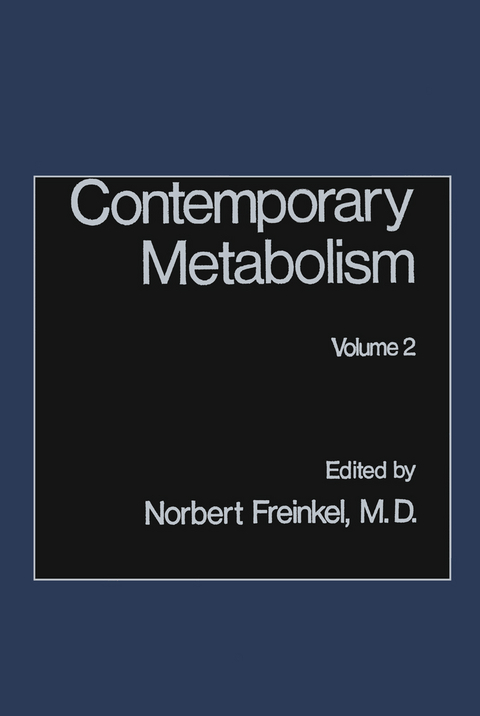
Contemporary Metabolism
Springer-Verlag New York Inc.
9781468441895 (ISBN)
It is abundantly clear that a number of subtle abnormalities in hypothalamic function are associated with human obesity. Some hormonal abnormalities-the diminished growth hormone responses, for example-are critically dependent on increased caloric intake and are quickly reversible with weight loss. Others, such as the blunted prolactin response to acute hypoglycemia, may persist in the reduced-obese state. Still others (e. g. , the blunted ACTH responses to insulin induced hypoglycemia) may, in some patients, first appear in the reduced-obese state. It remains uncertain whether any of these abnormalities is ever antecedent to the presence of obesity. Obviously, it is difficult to plan experiments in which the amounts of stored triglyceride, the level of caloric intake, and the state or his tory of obesity can all be individually evaluated. The issue is made even more complex by the fact that there may be subgroups of obese in whom hypothalamic function may be abnormal, whereas many obese may have nearly normal hypo thalamic function. It should be remembered that for years clinicians and investigators, working with available research tools, have ruled out pituitary or hypothalamic abnor malities as a cause of human obesity. These tools have oftentimes been no more sophisticated than skull roentgenograms and samples of excreted steroid hormones in 24-hr urine. The advent of radioimmunoassays for peptide hormones and the availability of synthetic releasing hormones have offered possibilities of studying hypothalamic function undreamed of just a few years ago.
1 Diabetes Mellitus: Selected Aspects of Pathophysiology and Clinical Practice.- 1.1. Introduction.- 1.2. Insulin Secretion.- 1.3. Insulin Action.- 1.4. Glucose Counterregulation after Insulin.- 1.5. High-Purity Insulin.- 1.6. Nonenzymatic Glycosylation of Proteins.- 1.7. Peripheral Neuropathy.- References.- 2 Glucagon: Secretion, Function, and Clinical Role.- 2.1. Anatomy of the Islets of Langerhans.- 2.2. Structure-Function Relationships of Glucagon.- 2.3. Pancreatic and Extrapancreatic Immunoreactive Glucagons.- 2.4. Glucagon Metabolism, Clearance, and Degradation.- 2.5. Actions of Glucagon.- 2.6. Control of Glucagon Secretion.- 2.7. Glucagonlike Immunoreactivity (Enteroglucagon).- 2.8. Importance of Glucagon in Clinical Medicine.- References.- 3 Hypothalamic-Pituitary Function in Obesity.- 3.1. Introduction.- 3.2. Obesity Syndromes with Known Hypothalamic Involvement.- 3.3. Involvement of the Hypothalamic-Pituitary Axis in Other Forms of Obesity.- 3.4. Hypothalamic-Pituitary Function in Idiopathic Human Obesity.- 3.5. Release of Growth Hormone in Obesity.- 3.6. Prolactin.- 3.7. Thyroid.- 3.8. ACTH and the Opioid Peptides.- 3.9. Summary.- References.- 4 Plasma Apolipoproteins and Lipoprotein Receptors: Role in the Metabolism of Lipoproteins.- 4.1. Introduction.- 4.2. Apolipoproteins.- 4.3. Cell Surface Receptors for Lipoproteins.- 4.4. Metabolism of Chylomicrons.- 4.5. Metabolism of Endogenous VLDL.- 4.6. Metabolism of LDL.- 4.7. Metabolism of HDL.- References.- 5 Alcohol, Amino Acids and Encephalopathy.- 5.1. The Role of Plasma Amino Acids in the Pathogenesis of Hepatic Encephalopathy.- 5.2. Depression of Plasma Branched-Chain Amino Acids in the Alcoholic.- 5.3. ?-Amino-n-Butyric Acid.- References.- 6 GABA and Taurine: What Are Metabolites Like This Doing in PlacesLike That?.- 6.1. Introduction.- 6.2. GABA.- 6.3. Taurine.- 6.4. Conclusion.- References.- 7 Nutrition and Aging.- 7.1. Introduction.- 7.2. Previous Nutrition and the Aging Process.- 7.3. Protein Metabolism in the Elderly.- References.- 8 Receptors and Second Messengers in Cell Function and Clinical Disorders.- 8.1. Introduction.- 8.2. Overview of Receptors, Second Messengers, and the Control of Cellular function.- 8.3. Coupling of Receptor Function to Cell Regulation.- 8.4. Second Messengers.- 8.5. Model Systems with Genetic Defects in Hormone Regulation.- 8.6. Specific Receptors, Their Regulation, and Second Messengers.- 8.7. Clinical Disorders and Adenylate Cyclase Systems.- References.- 9 Stimulated Phosphatidylinositol Turnover: A Brief Appraisal.- 9.1. General Introduction.- 9.2. What is Stimulated PI Turnover?.- 9.3. Mechanism of PI Turnover.- 9.4. Function of PI Turnover.- 9.5. Summary and Conclusions.- References.- 10 Disorders of Purine and Pyrimidine Metabolism: Basic and Clinical Considerations.- 10.1. Introduction.- 10.2. Purine Metabolism.- 10.3. Adenosine Deaminase Deficiency.- 10.4. Increased Adenosine Deaminase Activity.- 10.5. Purine Nucleoside Phosphorylase Deficiency.- 10.6. Lowered Purine 5?-Nucleotidase in Agammaglobulinemia.- 10.7. Adenine Phosphoribosyltransferase Deficiency.- 10.8. Hypoxanthine Guanine Phosphoribosyltransferase Deficiency.- 10.9 Increased Phosphoribosylpyrophosphate Synthetase.- 10.10. Xanthinuria.- 10.11. Gout.- 10.12. Decreased Adenylic Deaminase.- 10.13. Abnormalities of Pyrimidine Metabolism.- 10.14. Abnormal DNA Repair.- 10.15. Antineoplastic Drugs.- 10.16. Transcobalamin II Deficiency.- References.- 11 Metabolic Aspects of Urinary Stone Disease.- 11.1. Introduction.- 11.2. New Urinary Stone Diseases.- 11.3. CystineStone Disease.- 11.4. Struvite Stone Disease.- 11.5. Calcium Stone Disease.- References.- 12 The Divalent Ions: Calcium, Phosphorus, and Magnesium and Vitamin D.- 12.1. Calcium Metabolism.- 12.2. Vitamin D.- 12.3. Phosphate Metabolism.- 12.4. Magnesium Metabolism.- References.
| Erscheint lt. Verlag | 14.3.2012 |
|---|---|
| Zusatzinfo | 15 Illustrations, black and white |
| Verlagsort | New York |
| Sprache | englisch |
| Maße | 152 x 229 mm |
| Themenwelt | Naturwissenschaften ► Biologie ► Biochemie |
| ISBN-13 | 9781468441895 / 9781468441895 |
| Zustand | Neuware |
| Informationen gemäß Produktsicherheitsverordnung (GPSR) | |
| Haben Sie eine Frage zum Produkt? |
aus dem Bereich


